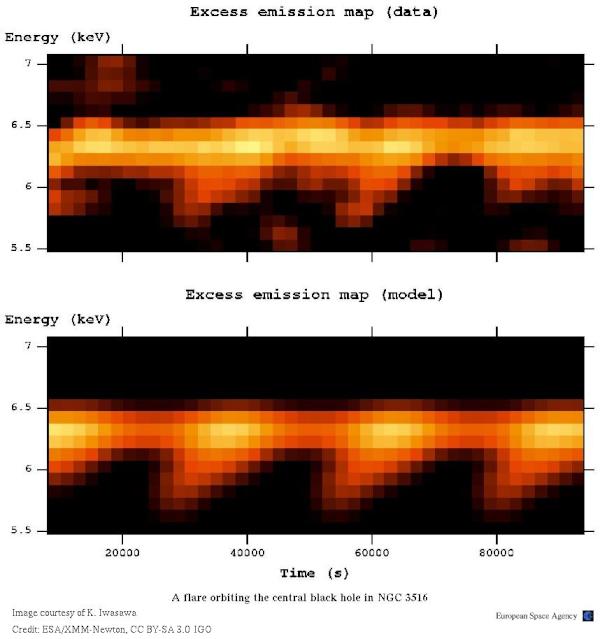A flare orbiting the central black hole in NGC 3516

Minimum credit line: Image courtesy of K. Iwasawa, G. Miniutti and A. Fabian and ESA. (for details, see Conditions of Use).
Credit: ESA/XMM-Newton, CC BY-SA 3.0 IGO
The image above can be displayed at full size and may be downloaded by clicking the image above.
| About this Image |
|---|
The upper panel shows the smoothed excess emission map on the time-energy plane for the Fe K? as measured for NGC 3516. The resolution is 100eV in energy and 2 ks in time. The colour coding is according to a �blackblody� with the brightest pixels correspond to about 15 excess counts. The spectral evolution agrees with emission arising from a spot on the accretion disc, illuminated by a corotating flare located at a radius of 3.5 - 8 Rs (Schwarzschild radii). The lower panels shows a theoretical picture for comparison.
Investigator(s): K. Iwasawa, G. Miniutti and A. Fabian
| For More Information |
|---|
- Read the Journal article
- Detailed description of this image
- Query XSA archive for XMM-Newton data in the field of NGC3516
- Astronomical database entries for NGC3516;
- Query NED for more images about NGC3516
- Query SIMBAD for more NGC3516 data
- For unfamiliar terms, visit the XMM-Newton Astronomical Glossary
| Instrument | EPIC pn | ||
| Observing Mode | Small Window | ||
| Filter | Thin | ||
| Date of Observation | 2001-04-10 | ||
| Image size | 26.00 x 26.00 arcmin | ||
| Detailed Caption | The upper panel shows the smoothed excess emission map on the time-energy plane for the Fe K? as measured for the Seyfert galaxy NGC 3516. The resolution is 100eV in energy and 2 ks in time. The colour coding is according to a �blackblody� with the brightest pixels correspond to about 15 excess counts. The figure shows the detection of the modulation of a transient, redshifted Fe K? emission feature in the X-ray spectrum. The detection of the spectral feature at 6.1 keV, in addition to a stable 6.4-keV line, has been reported previously. The feature varies systematically in flux at intervals of 25 ks. The peak moves in energy between 5.7 and 6.5 keV. The spectral evolution of the feature agrees with Fe K emission arising from a spot on the accretion disc, illuminated by a corotating flare located at a radius of (7-16) rg, modulated by Doppler and gravitational effects as the flare orbits around the black hole. Combining the orbital time-scale and the location of the orbiting flare, the mass of the black hole is estimated to be (1-5) � 107 Msolar, which is in good agreement with values obtained from other techniques. The lower panels shows a theoretical picture for comparison. | ||
| Alternate Resolutions | (Help) |
|---|
This image is available in the following downloadable versions: Higher resolution versions of this image may be available, please contact the XMM-Newton HelpDesk.
Search the Image Gallery
To search the Image Gallery for a particular object, fill in the object name in the box below and click the Submit button.To search the Image Gallery for other images, fill in any of the fields below and click the Submit button.
For more search options, please use our Advanced Search form.